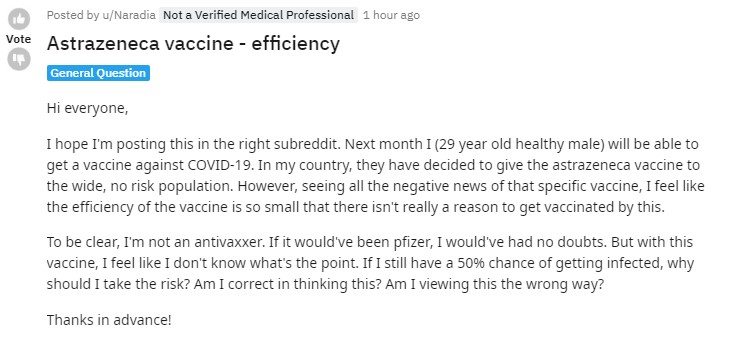Social listening analysis of COVID-19 vaccines: market research guide

Every day millions of people share their opinions, thoughts, and feelings online. They create social media posts, leave comments on videos and forums, and write blog posts. For many of us, it's exciting content, but for marketers and brands, it’s a gold mine of consumer data that can potentially revolutionize their product and business strategy.
Brands have access to different tools when it comes to market research and product research:
-
Polls
-
Focus groups
-
Surveys
and so on.
But these tools have a downside: you can only uncover insights based on the questions you ask. While you are able to get the exact answers you need, the way you phrase questions and highlight certain issues shapes the answers of your respondents and interviewees. Thus, the responses may come out a bit biased.
To battle these issues, you can add social listening to your market research tool stack. It takes the opposite route — social listening gathers online conversations dedicated to your topic of interest and analyzes them, breaking down your audiences, reputation, brand awareness, and so on. It takes organic unbiased data and organizes it in such a way that it starts making sense.
We at Awario are hands-on learners so we better show you how to conduct product research with social listening than write about it. And what’s the most discussed product on social media right now? COVID-19 vaccines!
There are multiple vaccination options available right now, so how do people choose which one to go with? How do they feel about COVID-19 vaccines in general? How could companies improve their service, make their offer more appealing, and help people more effectively?
All these questions can be answered with social listening!
Market research with social listening: COVID-19 vaccines
There are three major vaccine brands at the moment: Pfizer, Moderna, and AstraZeneca. All three are used around the world, from the USA to South Korea. To figure out how people feel about them, what they pay attention to when they mention the vaccines, and what affects their decision to vaccinate we used Awario. This blog post is a blueprint for market research that you can copy for your own product.
You can grab Awario's free trial here and follow along if you want to!
Step 1: Setting up monitoring alerts for Pfizer, AstraZeneca, and Moderna vaccines
To gather social listening data I set up monitoring alerts for the products I wanted to research: the three most popular COVID-19 vaccines.
Awario Tip: I also recommend monitoring your competitors: that way you’ll have another set of analytics to benchmark your results against. Additionally, you can find out what people like and dislike about your competitors’ products and use this knowledge to improve your own product.
I’ve set up a monitoring alert in Awario for each of the vaccines, so I was able to compare them with each other as well as see analytics of each vaccine. The tool allows you to choose from multiple criteria to make your monitoring efforts more focused. These criteria include:
-
Sources of the conversations
-
Locations
-
Languages
-
Time frame
Since the vaccines are distributed globally, I didn’t limit monitoring to any specific countries, but if you are interested in a specific local market, I highly recommend doing that. On the screenshot you can see the settings for the monitoring alerts I set up: product name became the keywords, and I didn't touch the rest of the settings since my goal was to analyze as much data as possible.

When you conduct market research, if your product's name could be used in another context (Apple, Tesla), you can add negative keywords to make sure you only get relevant data.
Once I created monitoring alerts for the vaccines, Awario immediately started collecting and analyzing online data. I've set up monitoring two months ago, however, Awario is able to find and analyze historical data, thus, some of the conversations analyzed date back to 2020. As you see on the screenshot, I didn't select a specific date range, but working with analytics, I mostly limited analyzed data to the last 3 months.
We now have access to tons of social listening analytics, for some, it may seem a bit overwhelming. So let's look at the essential metrics for market research one by one.
By signing up I agree to the Terms of Use and Privacy Policy
Step 2: Checking share of voice and brand awareness of the vaccines
Before I could dive into audience analytics, sentiment or reviews, I needed to estimate how popular these vaccines are. Awario shows how many conversations they generated and how many people saw these conversations.
In addition to that, Awario Insights shows you the reason behind sudden spikes in the number of mentions — a reason for this could be a post by an influencer or a new emerging trend.
Here's the number of mentions graph for the Moderna vaccine. In one month, it managed to generate more than five hundred thousand conversations, with prominent spikes at the end of January and the middle of February. On February 11th, Moderna saw a spike in mentions caused by a tweet by Kyle Griffin, MSNBC's producer. He tweeted that the USA signed a contract with Pfizer and Moderna.

The January spike in mentions was caused by a tweet from Moderna itself: it announced that their vaccine proved to be effective against the new variant of the virus which brought them a 208% growth in the number of mentions.
We just announced that the Moderna COVID-19 Vaccine retains neutralizing activity against emerging variants first identified in the U.K. and the Republic of South Africa. Read more: https://t.co/UCCvX0PrKV pic.twitter.com/nCGl3hfhlU
— Moderna (@moderna_tx) January 25, 2021
Since I have alerts set up for three products, I can easily calculate Share of Voice for each of them, effectively comparing their brand awareness against each other. I did this by turning to the Alert Comparison dashboard and selecting the three vaccines.

As you see, the Pfizer vaccine takes up almost half of the conversation around COVID-19 vaccines. Moderna generates more conversation than AstraZeneca but loses when it comes to the reach of those conversations. That means that there are more influential accounts and websites talking about AstraZeneca than about Moderna.
All in all, I can say that while each of the vaccines has a high brand awareness level, Pfizer is the one enjoying the public spotlight.
Step 3: Looking at the vaccines' reputation
The next thing to check out is the product's reputation — this is represented by the sentiment analysis widget. Awario analyzes the overall sentiment of all the conversations around the product and assigns sentiment to each conversation simultaneously.
As my first move, I went on and checked sentiment for each of the vaccines. Here's a sentiment analysis of the conversations around the Moderna vaccine.

As you see, the sentiment graph also gives you access to Insights which breakdown what caused a large amount of negative and positive sentiment.
For example, this tweet by a doctor says that "A new phase II study from Moderna shows that half doses (50 µg) appear to be as good as full doses (100 µg) at generating neutralizing antibodies." The tweet caused a 285% increase in the number of positive mentions on February 15.
Buenas noticias de la vacuna de MODERNA:
— Cesar Carballo (@ccarballo50) February 15, 2021
"Un nuevo estudio de fase II de Moderna muestra que las medias dosis (50 μg) parecen ser tan buenas como las dosis completas (100 ug) para generar anticuerpos neutralizantes."
Once again, since I'm tracking the mentions of three different vaccines, I can compare them against each other.

The best positive/negative sentiment ratio belongs to Moderna, and Pfizer is an unfortunate leader when it comes to negative conversations. From there, we can go to the Mention Feed to take a look at the negative conversations and see what's wrong.
When we go through Pfizer's mentions, we discover a lot of mentions by influential media talking about the availability of the vaccine. Many negative conversations are related to shortages or the mistakes of distributors — like in Japan, where they had to throw away a large shipment of the vaccine because of a minor mistake.
Japan to discard millions of Pfizer vaccine doses because it has wrong syringes https://t.co/4yqSrSPHG1
— The Guardian (@guardian) February 10, 2021
By signing up I agree to the Terms of Use and Privacy Policy
Step 4: Examining the audience that talks about the vaccines
Market analysis sometimes reminds me of looking at exquisite art — I go from looking at the big picture to paying attention to the details. Brand awareness and sentiment are like big strokes that you notice first — these metrics allow you to understand what's happening with the product at first glance. To dive deeper and understand who stands behind those conversations I wanted to go through the demographic insights extracted from the conversations around the vaccines.
Here's what Awario is able to tell you about a product's target audience:
- Their gender
- Where they live
- Languages they speak
- What websites they use
- Account types: whether conversation comes from a personal or business account
- Most active users
- Most influential users
For example, here's the breakdown of the locations where mentions of Pfizer come from. If I move my mouth on the map, I can see how many conversations come from a particular country.

As for gender, there are more men talking about Pfizer than women.

If we look at the type of accounts that talk about the Pfizer vaccine, we find that 85,9% of them belong to people rather than represent media, companies, or state organizations.

That means that while most influential mentions of the vaccine come from media or governmental institutions, it's actively discussed by regular people who are explaining why they are going or not going to get a vaccine, sharing their experience of vaccination, arguing about its safety, and so on. This kind of data is the crème de la crème of market research. It shows how people actually feel about your product and what you can change to improve it.

Step 5: Key topics of the discussions around the vaccines
Now is the time to dive into the actual conversations about Pfizer, Moderna, and AstraZeneca Awario found. Before examining individual social media posts and articles dedicated to the vaccines, I wanted to check out the Topic cloud. This widget lets you see the words and phrases commonly used with your product.
Let's take a look at AstraZeneca's Topic cloud:

The most obvious words are vaccines (vacuna in Spanish), Oxford since the full name of the vaccine is Oxford-AstraZeneca, and COVID-19. What's more interesting are other words and combinations which hint at what topics dominate the conversation:
- Effectiveness indicates that one of the main topics is the success of the vaccine (7.5 thousand mentions).
- South Africa relates to the discussions around the new variant of COVID-19. People are wondering if the vaccine works against these new variants (15.2 thousand mentions). In addition to that, South Africa and India are often mentioned together due to the fact that South Africa decided to ship a large number of vaccines it received from the Serum Institute of India since it doesn't work against the South African variant of the virus.
- COVAX refers to the global vaccine program to spread vaccines around the world. People are mentioning it when discussing when vaccination will be available for them
The Topic cloud works as a treasure map by giving us some pointers on what topics should be the most important when it comes to our product but to truly know what customers think of it we need to look at the conversations at hand. Awario allows you to sort, filter, and group them in different ways for convenience.
I've filtered the Mention Feed for AstraZeneca to only show me languages in English from social media and sorted them by the number of comments and replies. Immediately, I found a lot of social media posts that doubt the effectiveness of the vaccine or its side-effects.
Mild? Mild? Clearly whoever wrote that headline hasn’t had the AstraZeneca vaccine ?
— Robert Blair (@RialbTrebor) February 6, 2021

The main issues people seem to have with the vaccine are its side-effects and the fact that it allegedly doesn't protect against the new variants of COVID-19. To be fair there was a lot of positive feedback as well. If I were actually conducting research for AstraZeneca, I'd suggest the company either change their marketing strategy or product to address these problems.
I'm an emergency doctor, directly treating covid patients.
— skcornamza (@azmanrocks) February 17, 2021
This is my stand on covid vaccine, be it Pfizer, AstraZeneca, SinoVac, Sputnik, etc.
I will take whichever first vaccine is available for me willingly. In fact I cannot wait to receive my vaccine. I know it is safe.
In conclusion
This is the basic workflow for market research — of course, you can strengthen and escalate it in your own practice. You can also combine social listening with other forms of market research, for example, contact people who posted a thoughtful review of your product and invite them for an interview or a focus group.
In the comments, let's talk about market research! Have you ever tried social listening for gathering product feedback? Alternatively, you can tell me how the vaccinations are going in your country — after all, as Awario showed us, it's the main topic around the world right now!













